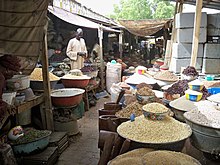Economy of Niger

Petit Marché in Niamey
|
|
| Currency | West African CFA franc (XOF) |
|---|---|
| Statistics | |
| GDP | $11.63 billion (2011 est.) |
|
GDP growth
|
2.3% (2011 est.) |
|
GDP per capita
|
$800 (2011 est.)(PPP, 176th) |
|
GDP by sector
|
agriculture: 39%; industry: 16.3%; services: 41.6% (2011 est.) |
| 2.9% (2011 est.) | |
|
Population below poverty line
|
63% (1993 est.) |
| 34 (2007) | |
|
Labour force
|
4.688 million (2007) |
|
Labour force by occupation
|
agriculture: 90%; industry: 6%; services: 4% (1995) |
|
Main industries
|
uranium mining, cement, brick, soap, textiles, food processing, chemicals, slaughterhouses |
| 150th (2017) | |
| External | |
| Exports | $786 million (2006) |
|
Export goods
|
uranium ore, , cowpeas, onions |
|
Main export partners
|
|
| Imports | $1.68 billion (2012) |
|
Import goods
|
Rice, machinery, vehicles and parts, petroleum, cereals |
|
Main import partners
|
|
|
Gross external debt
|
$1.342 billion (31 December 2011 est.) |
| Public finances | |
| Revenues | $1.385 billion (includes $134 million from foreign sources) |
| Expenses | $1.609 billion (2011 est.) |
The economy of Niger is based largely upon internal markets, subsistence agriculture, and the export of raw commodities: foodstuffs to neighbors and raw minerals to world markets. Niger, a landlocked West African nation that straddles the Sahel, has consistently been ranked on the bottom of the Human development index, with a relatively low GDP and per capital income. Economic activity centres on subsistence agriculture, animal husbandry, re-export trade, and export of uranium. The 50% devaluation of the West African CFA franc in January 1994 boosted exports of , cowpeas, onions, and the products of Niger's small cotton industry. Exports of cattle to neighboring Nigeria, as well as Groundnuts and their oil remain the primary non-mineral exports. The government relies on bilateral and multilateral aid – which was suspended briefly following coups d'état in 1996 and 1999 – for operating expenses and public investment. Short-term prospects depend on continued World Bank and IMF debt relief and extended aid. The post 1999 government has broadly adhered to privatisation and market deregulation plans instituted by these funders. Niger is the poorest country in the world.
This is a chart of trend of gross domestic product of Niger at market prices estimated by the International Monetary Fund with figures in millions of CFA Francs.
Mean wages were $0.37 per man-hour in 2008
.
Niger's economy is based largely on subsistence crops, livestock, and some of the world's largest uranium deposits. Drought cycles, desertification, a 3.4% population growth rate and the drop in world demand for uranium have undercut an already marginal economy. Traditional subsistence farming, herding, small trading, and informal markets dominate an economy that generates few formal sector jobs. Between 1988 and 1995 28% to 30% of the total economy of Niger was in the unregulated Informal sector, including small and even large scale rural and urban production, transport and services.
...
Wikipedia
